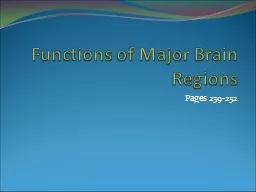

Pages 239252 Cerebrum General Functions Speech memory logicalemotional response Consciousness interpretation of sensation Voluntary movement Speech CEREBRAL FUNCTIONS by Lobes Parietal ID: 715093
Download Presentation The PPT/PDF document "Functions of Major Brain Regions" is the property of its rightful owner. Permission is granted to download and print the materials on this web site for personal, non-commercial use only, and to display it on your personal computer provided you do not modify the materials and that you retain all copyright notices contained in the materials. By downloading content from our website, you accept the terms of this agreement.
Slide1
Functions of Major Brain Regions
Pages 239-252Slide2
Regions of the Brain
Cerebral hemispheres (cerebrum)
Diencephalon
Brain stemCerebellum
© 2015 Pearson Education, Inc.Slide3
CEREBRUM:
Functions
by
LobesFrontal:
Primarily motor function
Prefrontal Cortex
(anterior association)
attention, memory, decisions
Parietal
: primarily sensory stimuli integration
Touch/tactile, spatial information, body position
Temporal
: Auditory and Olfactory
stimuli integration
Broca’s
area
: motor component of speech- saying words
Occipital
: Visual
stimuli integrationSlide4
Figure 7.13c Left lateral view of the brain.
Primary motor area
Premotor area
Anterior
association area
Working
memory and
judgment
Broca’s
area
(motor speech)
Olfactory
area
Central sulcus
Primary somatic
sensory area
Gustatory area
(taste)
Speech/language
(outlined by dashes)
Posteriorassociationarea
Visual area
Auditory area
Problemsolving
Languagecomprehension
(c)Slide5
Diencephalon
An anatomical location made up of the:
thalamus
hypothalamus
e
pithalamus
: roof of third ventricle and pineal gland
© 2015 Pearson Education, Inc.Slide6
Figure 7.16a Diencephalon and brain stem structures.
Third ventricle
Anterior
commissure
Hypothalamus
Optic chiasma
Pituitary gland
Mammillary body
Pons
Medulla oblongata
Spinal cord
(a)
Cerebral hemisphere
Corpus callosum
Choroid plexus of third
ventricle
Occipital lobe of
cerebral hemisphere
Thalamus
(encloses third ventricle)
Pineal gland
(part of
epithalamus
)
Corpora quadrigemina
Cerebral aqueduct
Cerebral peduncle
Fourth ventricle
Choroid plexus
Cerebellum
MidbrainSlide7
Diencephalon-
Thalamus
Helps shape third ventricle walls
the
Gateway
structure
Relay station
for sensory impulses
Sends impulses to cortex for interpretation
All parts of the brain communicating with the cerebral cortex MUST send signals through the thalamus
© 2015 Pearson Education, Inc.Slide8
Diencephalon-
Hypothalamus
Helps shape third ventricle walls
Exerts control over the
autonomic nervous system
Regulates: body temperature, water balance/thirst, metabolism/hunger, heart rate, blood pressure
Houses
limbic center
(emotional response)
emotions and drivesRegulates pituitary glandHouses
mammillary bodies (reflex centers for smell)© 2015 Pearson Education, Inc.Slide9
Diencephalon-
Epithalamus
Helps shape roof of third ventricle
Houses the
pineal gland
produces hormone
melatonin
regulates sleep cycles and reproductive
behaviors
Includes the choroid plexus of the 3
rd ventricle© 2015 Pearson Education, Inc.Slide10
Figure 7.16a Diencephalon and brain stem structures.
Third ventricle
Anterior
commissure
Hypothalamus
Optic chiasma
Pituitary gland
Mammillary body
Pons
Medulla oblongata
Spinal cord
(a)
Cerebral hemisphere
Corpus callosum
Choroid plexus of third
ventricle
Occipital lobe of
cerebral hemisphere
Thalamus
(encloses third ventricle)
Pineal gland
(part of epithalamus)
Corpora
quadrigemina
Cerebral aqueduct
Cerebral peduncle
Fourth ventricle
Choroid plexus
Cerebellum
Midbrain
Structures of the Brain StemSlide11
Brain Stem-
Midbrain
cerebral peduncles:
two bulging fiber tracts that convey ascending and descending impulses
Located
anteriorly
cerebral aqueduct:
allows passage of CSF
corpora
quadrigemina: four rounded protrusions that are the visual and auditory reflex
Also called superior and inferior colliculiLocated posteriorly© 2015 Pearson Education, Inc.Slide12
Brain Stem-
Pons
The
anteriorly
bulging center part of the brain stem
Mostly composed of fiber tracts
Includes nuclei involved in the control of
respiration
© 2015 Pearson Education, Inc.Slide13
Brain Stem-
Medulla oblongata
Merges into the spinal cord
Houses
fourth ventricle
Connects projection fiber tracts from the cerebrum
Homeostatic control center for autonomic
fxs
:
Heart rate control
Blood pressure regulation
RespirationSwallowing/Vomiting© 2015 Pearson Education, Inc.Slide14
Brain Stem-
Reticular Formation
Gray
matter along the
entire
brain stem
Plays a role in motor
control of visceral (internal) organs
Includes the
Reticular Activating System (RAS) Assists in wake/sleep cycles and consciousness
sensory information filter© 2015 Pearson Education, Inc.Slide15
Cerebellum
Controls balance/posture
and
equilibrium
Coordination
of body
movements and fluid contraction of skeletal muscle
Alcohol
affects coordination via the cerebellum
© 2015 Pearson Education, Inc.Slide16
Figure 7.16a Diencephalon and brain stem structures.
Third ventricle
Anterior
commissure
Hypothalamus
Optic chiasma
Pituitary gland
Mammillary body
Pons
Medulla oblongata
Spinal cord
(a)
Cerebral hemisphere
Corpus callosum
Choroid plexus of third
ventricle
Occipital lobe of
cerebral hemisphere
Thalamus
(encloses third ventricle)
Pineal gland
(part of epithalamus)
Corpora quadrigemina
Cerebral aqueduct
Cerebral peduncle
Fourth ventricle
Choroid plexus
Cerebellum
Midbrain
This
midsagittal
section shows the gray matter outlining the arbor vitae (white)
The Cerebellum